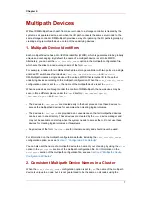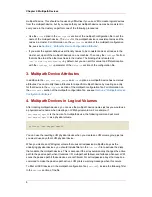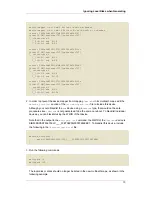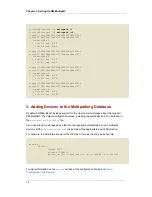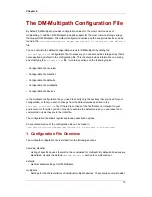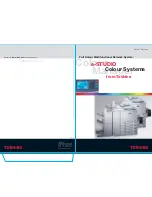
Multipath Devices
Without DM-Multipath, each path from a server node to a storage controller is treated by the
system as a separate device, even when the I/O path connects the same server node to the
same storage controller. DM-Multipath provides a way of organizing the I/O paths logically, by
creating a single multipath device on top of the underlying devices.
1. Multipath Device Identifiers
Each multipath device has a World Wide Identifier (WWID), which is guaranteed to be globally
unique and unchanging. By default, the name of a multipath device is set to its WWID.
Alternately, you can set the
user_friendly_names
option in the multipath configuration file,
which sets the alias to a node-unique name of the form
mpathn
.
For example, a node with two HBAs attached to a storage controller with two ports via a single
unzoned FC switch sees four devices:
/dev/sda
,
/dev/sdb
,
dev/sdc
, and
/dev/sdd
.
DM-Multipath creates a single device with a unique WWID that reroutes I/O to those four
underlying devices according to the multipath configuration. When the
user_friendly_names
configuration option is set to
yes
, the name of the multipath device is set to
mpathn
.
When new devices are brought under the control of DM-Multipath, the new devices may be
seen in three different places under the
/dev
directory:
/dev/mapper/mpathn
,
/dev/mpath/mpathn
, and
/dev/dm-n
.
• The devices in
/dev/mapper
are created early in the boot process. Use these devices to
access the multipathed devices, for example when creating logical volumes.
• The devices in
/dev/mpath
are provided as a convenience so that all multipathed devices
can be seen in one directory. These devices are created by the
udev
device manager and
may not be available on startup when the system needs to access them. Do not use these
devices for creating logical volumes or filesystems.
• Any devices of the form
/dev/dm-n
are for internal use only and should never be used.
For information on the multipath configuration defaults, including the
user_friendly_names
configuration option, see see
Section 3, “Configuration File Defaults”
.
You can also set the name of a multipath device to a name of your choosing by using the
alias
option in the
multipaths
section of the multipath configuration file. For information on the
multipaths
section of the multipath configuration file, see see
Section 4, “Multipaths Device
Configuration Attributes”
.
2. Consistent Multipath Device Names in a Cluster
When the
user_friendly_names
configuration option is set to
yes
, the name of the multipath
device is unique to a node, but it is not guaranteed to be the same on all nodes using the
Chapter 2.
7
Summary of Contents for DEVICE-MAPPER MULTIPATH 4.6
Page 4: ...Using Device Mapper Multipath ...
Page 6: ...vi ...
Page 16: ...6 ...
Page 19: ...filter r disk r sd a Multipath Devices in Logical Volumes 9 ...
Page 20: ...10 ...
Page 35: ... path_checker tur rr_weight priorities Configuration File Devices 25 ...
Page 36: ...26 ...















